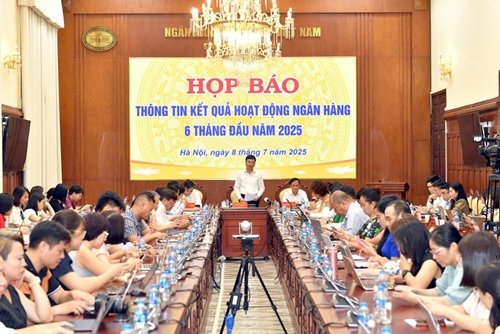This robust expansion signals a strong recovery in lending activities, particularly in production and business sectors, and industries that the Government prioritizes, according to Deputy Governor of the State Bank of Vietnam (SBV) Pham Thanh Ha.
    |
 |
|
Vietnam's credit growth hits highest level since 2023 |
Speaking at a press conference on the banking sector’s six-month performance on July 8, Ha noted that credit growth is aligned with the structure of the economy, meeting the capital needs of individuals and businesses.
As of the end of May, loans for the agriculture, forestry, and fishery sectors accounted for 6.54% of total outstanding loans; manufacturing and processing made up 10.39%; construction, especially infrastructure projects under government priority, represented 7.77%. The wholesale and retail sector held the largest share at 23.86%.
Crucially, lending to priority sectors continued to grow. Loans to agriculture and rural areas accounted for 23.16%; and small and medium-sized enterprises (SMEs) 19%.
Meanwhile, lending to supporting industries and high-tech enterprises grew by 15.69% and 17.59%, respectively, twice the pace of the economy’s average credit growth rate.
Ha said the SBV has proactively assigned credit growth limits to credit institutions this year, and set an annual credit growth of 16% for 2025, with room for flexible adjustments depending on market conditions.
Credit institutions have been instructed to focus lending on production, agriculture, SMEs, and high-tech industries, while maintaining tight control over loans to high-risk sectors such as real estate and corporate bonds.
The banking sector is also implementing several large-scale lending programs to support economic priorities, including a 145 trillion VND credit package for social and worker housing; a 500 trillion VND program to fund infrastructure and digital transformation works in key national projects; and 100 trillion VND fund to support the agriculture, forestry, and fishery sectors.
In addition to boosting credit growth, the SBV has maintained a stable interest rate policy to ensure affordable capital for banks, thereby lowering borrowing costs for businesses and individuals.
Foreign exchange markets have also remained stable. Despite global uncertainties, the SBV has adopted flexible exchange rate management and coordinated monetary tools to support macroeconomic stability and inflation control.
The sharp credit growth in the first half of the year reflects joint efforts by the SBV and the banking system to unleash capital flows, support businesses, and revive economic momentum.
This is considered foundational for promoting economic growth in the second half of 2025 and approaching a GDP growth of over 8% for the year 2025 as targeted by the Government.
Source: VNA